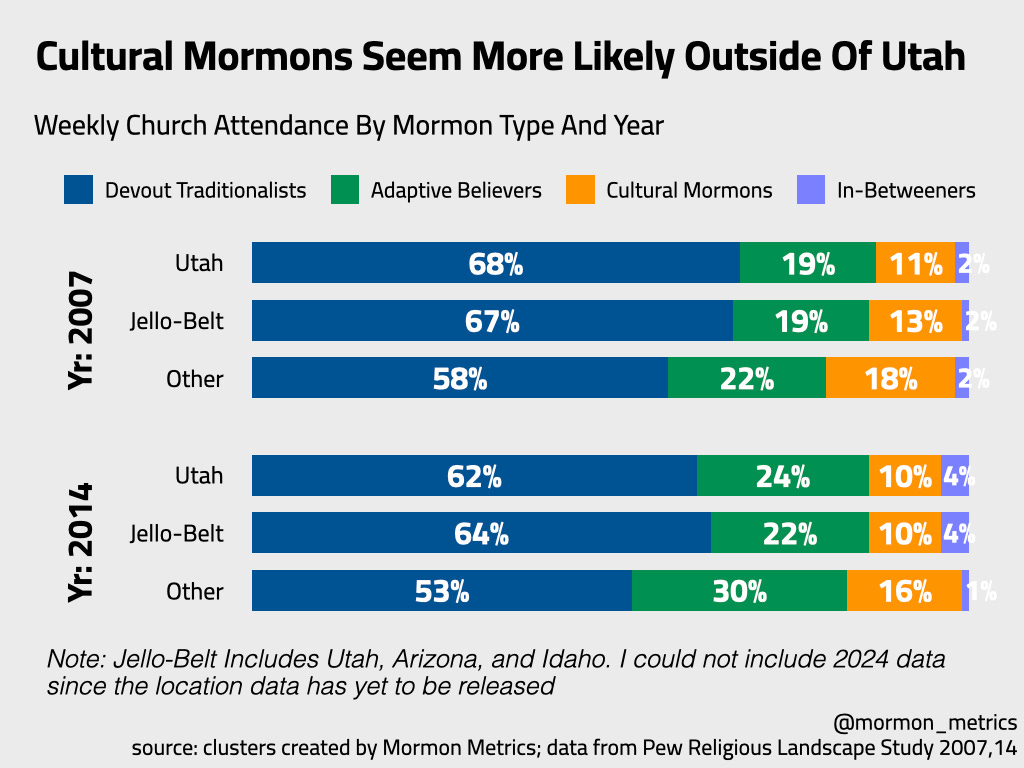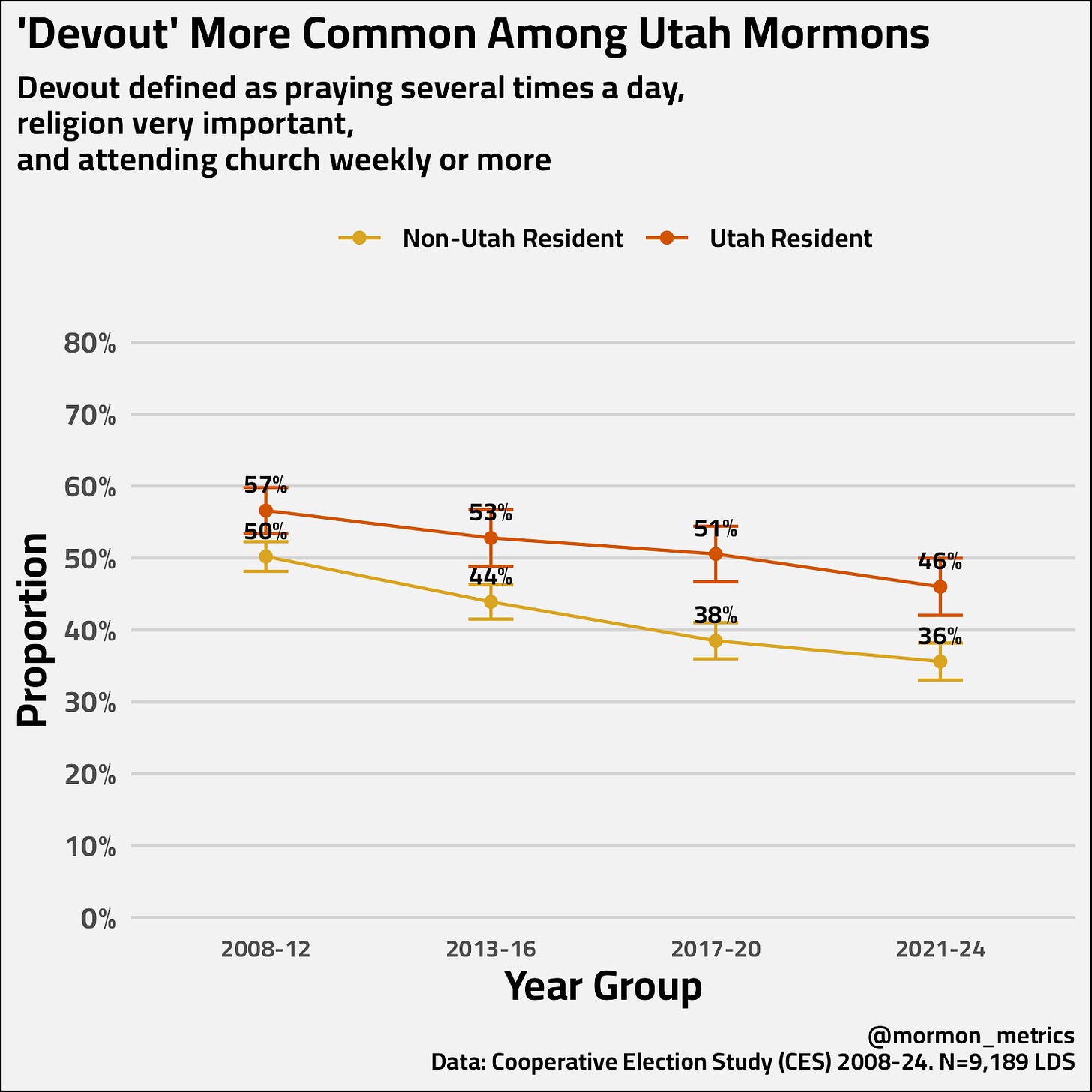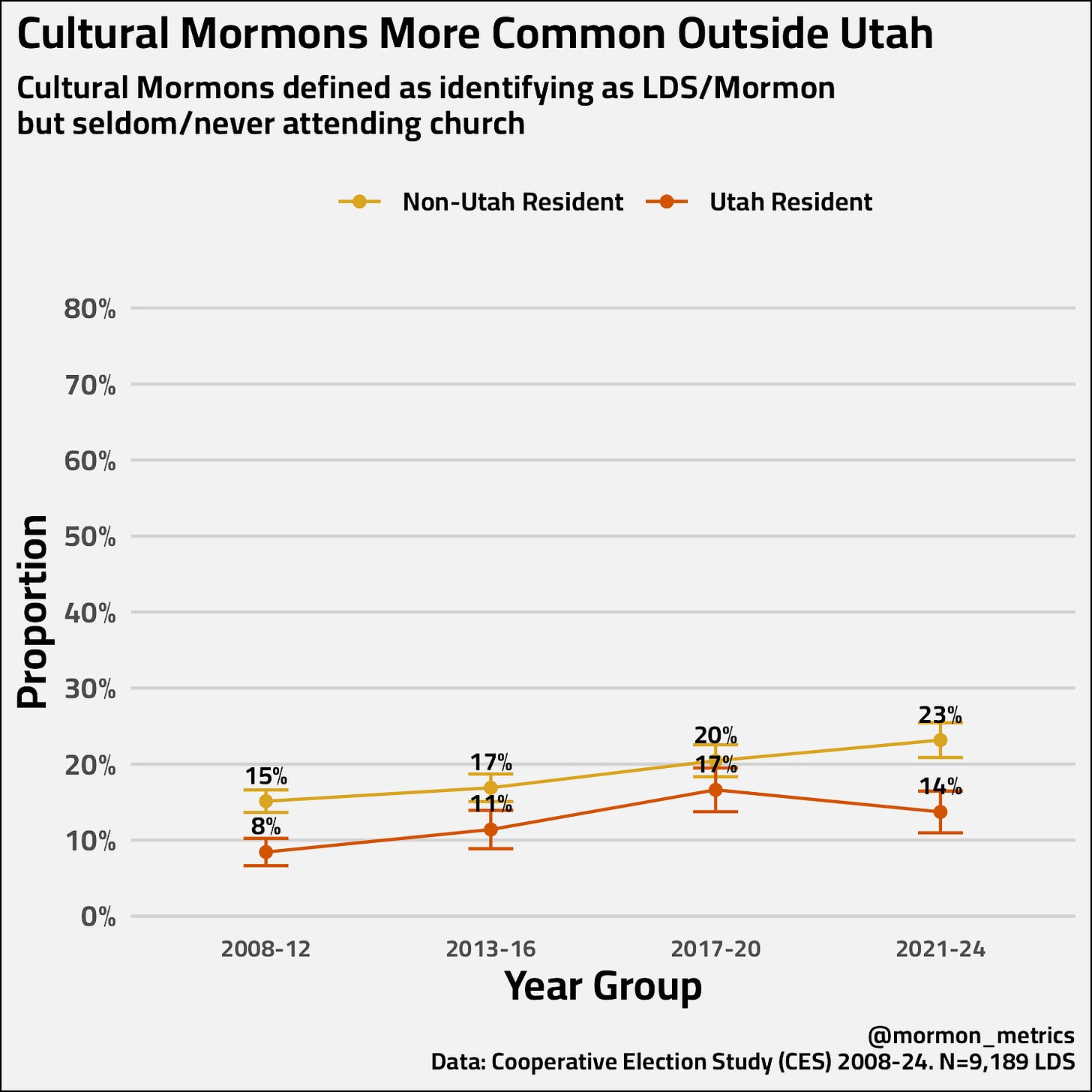Are "Devout" Mormons More Common Inside Or Outside Of Utah?
Exploring a trend against the narrative

Introduction
A lot of times data work confirms your suspicions and your assumptions, but sometimes you learn new and interesting things that may seem counterintuitive on the surface. Today, I’ll talk about one of these things that surprised me and maybe you, too. Contrary to the stereotype, my data shows that “devout” Latter-day Saints are more common in Utah, and Cultural Mormons are more prevalent outside of it.
Growing up in the church in Tennessee, there was a permeable feeling of skepticism and resistance to Utah Mormons. There was a lot of talk of plastic surgery, focusing on the wrong things, scores of cultural Utah Mormons, and other “bad” things that weren’t like the rest of the church outside of Utah.
In one of my adolescent memories, I attended EFY in Bowling Green, KY. Most of the youth there were from the states and areas around Kentucky, but one girl I danced with one night was from Utah. “Oh, you’re one of those Utah Mormons,” I said. She reacted strongly and got visibly angry saying something like “What’s wrong with Utah Mormons? Everyone keeps saying that and I don’t understand.” I was just trying to be playful in my untactful 14yo way, and didn’t know what to say when she responded strongly and just muttered something like “I don’t know it was just a joke.” I was equal parts surprised that she reacted strongly and that I was saying the same thing that apparently every other 14yo boy was saying to her.
Perhaps there are legitimate reasons why this stigma exists, but my view is this stigma is unfounded in many respects. In the data I’ve looked at, many of the reasons behind the stigma just aren’t true.
In previous posts I’ve written:
Utah is actually a great place to live for many strong reasons and Utah Latter-day Saints have strongly contributed to that (check out my 5 part LDS enclave series). Latter-day Saints should be proud of that!
Those who grew up in Utah are more likely to stay in the church than those who grew up in other states in the US.
And, as we’ll explore in this post, Utah Latter-day Saints are more likely to be devout and Cultural Mormons are more common outside Utah!
So while I do like to keep my opinions to a minimum in these posts, I think the data show us a story that many people miss about Utah and Utah Latter-day Saints. Of course if you disagree with me, tell me why I’m wrong in the comments.
Let’s look at a few charts!
Charts
So, let’s start with the typology and the Pew Religious Landscape data. Across two separate years, our data suggests that devout members are more likely inside Utah and the Jello-belt and cultural members are more likely outside.
The gap isn’t terribly big and the two waves have around 500-600 self-identified Mormons each.
Let’s see if we can replicate this finding with the CES data.
Again, while we can’t exactly replicate the clusters in the CES data, we can create a proxy devout by filtering to those who score the highest on each religious measure.
Over time, we see devout inside and outside of Utah declining, but notice for each year group Utah residents are statistically significantly more likely to be devout. While I didn’t include a chart, we see the same trend inside and outside the Jello-belt (Idaho, Utah, Arizona).
Now let’s see if this trend also holds for Cultural Mormons. Are Cultural Mormons more likely to be found outside Utah and Jello-belt? I define cultural Mormon here as someone who identifies as LDS or Mormons, but says they never/seldom attend church.
Let’s take a look.
Our CES data confirms that Cultural Mormons seem to be more likely outside of Utah and this is statistically significant in 3 of our 4 year groups. In the most recent years, proportionally there are 50% more cultural Mormons outside of Utah vs inside.
Theories
Ok so devout are more common inside Utah, cultural more common outside. Why?
I am not really sure, but here are some theories I have.
There could be some self selecting going on with moving. For example, perhaps people who are more devoutly Mormon want to live in an area where there are other Mormons. So people who want the religion more in their life, move to Utah and these people are more likely to be devout. People who don’t want the religion as a large part of their life, but want to still identify may be more comfortable living outside Utah where the religion isn’t in their face all the time.
In a previous post, I found that those who grew up in Utah were more likely to stay in the church than those who grew up outside. There perhaps is a socialization effect. Since perhaps more people you see around go to LDS church in Utah, you are also more likely to do so.
What do you think about this? Do you have another theory that I missed? Let me know what you think in the comments and see you next week!
Cluster recreation code available in the appendix of my typology. CES code available here.





I found these results interesting, but I think it is because I think of a cultural Mormon differently. I think of it as someone who attends church but is not really devout and only goes for the social aspects. I understand that it would be hard to determine who in the data set fits that definition. With your definition I can see that cultural Mormon’s would be more common outside Utah and the Jello belt. But with my definition I think the numbers would be flipped. I live in Maryland which means that any type of church service or going to meetings results in more time being required because of travel time. Walking to church or ministering or to drop something off at another members home is different from getting in the car and driving 10, 20, or 30 minutes (or more in some cases). Because of this I have often felt that it is hard to be a lukewarm member where the church is more spread out. Being “active” just takes more time.
This post also makes me think about the idea of “Mormon culture” that comes from Utah and to some extent other places in the jello belt. Because most of the wards in my stake have large numbers of western transplants, I feel that there are some definite influences of that western Mormon culture here. I find it even in myself, a convert of 40 years who has never lived in Utah (except for the MTC), because that has been the predominant influence in my wards. If you go to church in units in small towns in the midwest, south, or east there is a much different culture in those units. In the most recent changes in the handbook, I feel that the goal is to use doctrine and then principles to guide the administration of a worldwide church. In the past the handbook was much more influenced by “Mormon culture” based upon the ways things had been done. These were not bad, but they often did not scale or transfer well to other areas of the world (e.g., the pre-block meeting schedule that was a huge burden on those who had to travel long distances to get to church). So I believe this is an exciting time in the church as leaders are given the basic doctrines and principles to use in leading and administering the church, then they are encouraged to seek the inspiration that they are entitled to as they seek to do what is best for their members. As Elder Holland said, “Dream dreams.”
I hate it when the data refutes my biases! Although, I also want to second Eric's point about cultural mormons being more those who show up because its expected but who don't personally practice or believe (as well as his point that identifying such trends in data like these is essentially impossible, no worries) - actually, do you think it could be possible to try and identify such a population by examining those who attend weekly but rank religious importance/prayer/scripture/etc. as less than very important?
My experience with "Utah Mormons", being from the Pacific Northwest or "Heathenland" as I've heard it called, mostly involves arrogance on their part. That no good thing can come from anywhere in the church outside of Utah. I've definitely felt like a second-class member in their company. This has been ESPECIALLY true of missionaries from Utah, who just can't wait to go home to where the church is true again.
But, I've also long heard it said that unfortunately (for the narrative), you'll find the best members of the church in Utah. Also the worst, but the former still outnumber the latter. And the data seems to bear that up. It would be so cool if the church (or some related entity) conducted an LDS survey on the same scale or level of detail as Pew's!